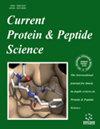Recent Advancement in Novel Wound Healing Therapies by Using Antimicrobial Peptides Derived from Humans and Amphibians
IF 2
4区 生物学
Q4 BIOCHEMISTRY & MOLECULAR BIOLOGY
引用次数: 0
Abstract
: The skin is the biggest organ in the human body. It is the first line of protection against invading pathogens and the starting point for the immune system. The focus of this review is on the use of amphibian-derived peptides and antimicrobial peptides (AMPs) in the treatment of wound healing. When skin is injured, a chain reaction begins that includes inflammation, the formation of new tissue, and remodelling of existing tissue to aid in the healing process. Collaborating with non-immune cells, resident and recruited immune cells in the skin remove foreign invaders and debris, then direct the repair and regeneration of injured host tissues. Restoration of normal structure and function requires the healing of damaged tissues. However, a major issue that slows wound healing is infection. AMPs are just one type of host-defense chemicals that have developed in multicellular animals to regulate the immune response and limit microbial proliferation in response to various types of biological or physical stress. Therefore, peptides isolated from amphibians represent novel therapeutic tools and approaches for regenerating damaged skin. Peptides that speed up the healing process could be used as therapeutic lead molecules in future research into novel drugs. AMPs and amphibian-derived peptides may be endogenous mediators of wound healing and treat non-life-threatening skin and epithelial lesions. Hence, this article describes different peptides used in wound healing, theirmethods of preparation, and their routes of administration.利用从人类和两栖动物中提取的抗菌肽开发新型伤口愈合疗法的最新进展
:皮肤是人体最大的器官。它是抵御病原体入侵的第一道防线,也是免疫系统的起点。本综述的重点是两栖动物肽和抗菌肽(AMPs)在伤口愈合治疗中的应用。当皮肤受伤时,一连串的反应就会开始,包括炎症、新组织的形成和现有组织的重塑,以帮助伤口愈合。皮肤中的常驻和招募免疫细胞与非免疫细胞合作,清除外来入侵者和碎片,然后指导受伤宿主组织的修复和再生。恢复正常结构和功能需要受损组织的愈合。然而,减缓伤口愈合的一个主要问题是感染。AMPs 只是宿主防御化学物质的一种,它在多细胞动物中发展起来,用于调节免疫反应和限制微生物增殖,以应对各种类型的生物或物理压力。因此,从两栖动物体内分离出的肽是再生受损皮肤的新型治疗工具和方法。加速愈合过程的肽可作为治疗先导分子,用于未来的新型药物研究。AMPs 和两栖动物提取的肽可能是伤口愈合的内源性介质,可治疗不危及生命的皮肤和上皮损伤。因此,本文介绍了用于伤口愈合的各种肽、其制备方法和给药途径。
本文章由计算机程序翻译,如有差异,请以英文原文为准。
求助全文
约1分钟内获得全文
求助全文
来源期刊

Current protein & peptide science
生物-生化与分子生物学
CiteScore
5.20
自引率
0.00%
发文量
73
审稿时长
6 months
期刊介绍:
Current Protein & Peptide Science publishes full-length/mini review articles on specific aspects involving proteins, peptides, and interactions between the enzymes, the binding interactions of hormones and their receptors; the properties of transcription factors and other molecules that regulate gene expression; the reactions leading to the immune response; the process of signal transduction; the structure and function of proteins involved in the cytoskeleton and molecular motors; the properties of membrane channels and transporters; and the generation and storage of metabolic energy. In addition, reviews of experimental studies of protein folding and design are given special emphasis. Manuscripts submitted to Current Protein and Peptide Science should cover a field by discussing research from the leading laboratories in a field and should pose questions for future studies. Original papers, research articles and letter articles/short communications are not considered for publication in Current Protein & Peptide Science.
 求助内容:
求助内容: 应助结果提醒方式:
应助结果提醒方式:


